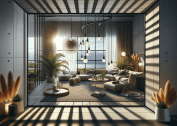Everyone craves a relaxing space, but many overlook just how much simple lifestyle changes can transform a home into a sanctuary. Discover practical, research-backed ideas for creating a peaceful environment without overhauling your life. This guide reveals subtle ways to reduce stress and invite more tranquility into your daily routine.
Understanding Why Calm Spaces Matter
Modern life feels busy. Finding calm at home can be surprisingly powerful. Psychologists highlight how a peaceful environment lowers stress hormones and benefits mental health. Even small shifts in the home atmosphere help the mind slow down and recharge. When people enter a soothing space, their body’s stress indicators drop quickly. This is why wellness advocates often recommend environment-focused changes before major lifestyle overhauls. According to research, incorporating calming textures, neutral colors, and natural lighting can elevate mood and improve emotional resilience. These small touches are accessible to most people seeking more peace at home.
Not everyone notices the silent impact of a cluttered or noisy environment. For many, a sanctuary isn’t about luxury, but about feeling safe and comfortable. The science of environmental psychology suggests that layout, lighting, scent, and sound all influence relaxation. A carefully arranged living room or a decluttered entryway might appear trivial, yet these details are closely linked to well-being. Regular exposure to an overstimulating environment, in contrast, can lead to restlessness and even sleep disruption. In fact, decluttering has been shown to reduce the cortisol levels that drive chronic stress (https://www.ncbi.nlm.nih.gov/pmc/articles/PMC4465119/).
Achieving calm doesn’t require a major home renovation. Start with awareness. Observe what triggers tension: bright fluorescent lights, persistent device notifications, or stacks of laundry left undone. Each can lead to low-level angst that builds over time. Creating a calm home means looking for easy wins—closing doors to keep out noise, softening lights, or pausing to diffuse scents. Small adjustments, repeated day after day, create an environment better attuned to relaxation and recovery. Anyone can benefit from these simple foundational shifts, regardless of style or budget.
Decluttering and Its Surprising Psychological Effects
Clutter creeps up fast. One day, a space feels open; the next, it feels crowded. Experts say clutter isn’t just physical—it’s deeply psychological. It can subtly steal focus and feed ongoing stress. Research from leading universities suggests that even invisible clutter, like digital mess or untended to-do lists, weighs heavily on mental health. Clearing out physical possessions, digitizing paperwork, or even sorting out a neglected inbox can all free up bandwidth. People often report a sense of lightness with each decluttering step.
Why does this matter for calm? A tidy space signals safety and order to the brain. Mess, in contrast, keeps the mind on high alert. Organizing experts recommend starting small: one drawer, one corner, one shelf. Each success, however minor, creates positive momentum. Over time, the habit of letting go of unnecessary things supports a more balanced and restful home life. It becomes easier to let go of tension when the external environment feels manageable. For those craving instant inspiration, even turning a storage box into a “maybe” pile can be a manageable first action that leads to more calm.
Decluttering’s benefits ripple outward. It can help with sleep, productivity, and social connections because guests often feel more at ease in an organized setting. Some studies link tidier homes to better dietary choices and reduced anxiety. The concept has even found its way into popular culture in the form of minimalist design trends and home organization shows. Ultimately, creating open, uncluttered spaces is an act of self-care. It invites harmony, signals closure to busy workdays, and encourages rituals that support overall wellness (https://www.apa.org/news/press/releases/2020/03/organized-home).
Natural Light and Indoor Greenery: Transform Simple Spaces
Light shapes mood. Natural sunlight boosts energy, supports circadian rhythms, and helps regulate stress. Home design experts often prioritize windows, sheer curtains, and reflective surfaces to enhance daylight. Even in small apartments, moving furniture closer to light sources creates a sense of openness. Studies confirm that regular sun exposure can lower anxiety and improve sleep quality by reinforcing biological rhythms. Opening blinds, using mirrors, or even choosing lighter paint colors can make a world of difference for people seeking a less stressful home environment.
Plants have a similar effect. Incorporating greenery has tangible wellness benefits. Indoor plants filter air, add visual interest, and create a subtle sense of connection to nature, which can be grounding in a fast-paced world. The “biophilic” design movement explores how even a few small potted plants can improve mood, focus, and productivity. Research highlights that just glimpsing green foliage can decrease physiological signs of stress. Those who work from home find that plants bring a refreshing contrast to screens and synthetic materials, softening the feel of a space (https://www.sciencedirect.com/science/article/pii/S0360132318304152).
The beauty of natural light and greenery is their versatility. There’s no need for a large garden or panoramic windows. Even a single well-placed succulent or a collection of resilient houseplants introduces peaceful vibes. Consider herbs in the kitchen or a statement container for the living room. Move plants to spots that get more daylight for a quick boost. For those concerned about maintenance, easy options like snake plants or pothos thrive with little attention, while still purifying indoor air and shaping the feel of a home.
Calming Scents, Textures, and Sounds: Multi-Sensory Comfort
The senses drive relaxation. Scent, touch, and sound play a subtle but powerful role in home ambiance. Gentle linens, cozy throws, or soft rugs change the mood instantly. Aromatherapy—using scents like lavender, eucalyptus, or cedar—can lower heart rate and even ease mild anxiety. Recent wellness trends recommend rotating seasonal scents or creating dedicated relaxation corners with soothing lighting. By layering sensory comforts, a home can support deep relaxation at the end of a busy day.
Sound matters, too. Unwanted noise can interrupt the most beautifully styled room. White noise machines, soft music, or even the hum of a fan can block distractions and promote restful sleep. In open-plan homes, soft surfaces absorb echo, making rooms feel more private. The benefit? Less overwhelm, more time for restful routines and quiet reflection. When families or roommates share spaces, earphones or sound-absorbing panels create personal sound sanctuaries, giving everyone a chance to recharge (https://www.sleepfoundation.org/noise-and-sleep).
Changing textures can spark a sense of comfort, too. Try rotating throw blankets or updating pillow covers for the season. Embracing small tactile pleasures, whether the feel of a favorite mug or slippers, roots the body in the present moment. Texture isn’t just visual; it’s experiential. Some people even use textured wallpaper or wall art to create visual warmth without extra clutter. Over time, choosing calming sensory details becomes second nature—a personalized toolkit for a more harmonious home environment.
Technology Boundaries: Creating Digital-Free Retreats
Digital devices are everywhere. They keep people connected, but constant alerts and information have a silent mental cost. Research shows that high screen time and relentless notifications can increase anxiety and disrupt sleep quality. One solution gaining momentum is the “tech-free zone”: an area—often bedrooms or reading corners—where phones and screens are absent. Setting up these spaces supports deeper rest and more mindful end-of-day routines, giving the mind time to decompress before sleep.
Establishing tech boundaries isn’t about restriction. It’s about reclaiming focus and presence at home. In practice, this could mean a charging station outside bedroom doors, analog clocks by the bed, or designating an hour for device-free relaxation each evening. Families especially benefit from shared tech-free meals or board game nights. Over time, small rituals like shutting down devices can nurture better sleep and more meaningful in-person connections (https://www.sleepfoundation.org/sleep-hygiene/technology-and-sleep).
For those worried about missing out, experts suggest starting with gradual, manageable changes. Even leaving the phone in another room for 20 minutes of reading can help. People quickly notice a difference in focus and relaxation. Over weeks, these digital boundaries start to feel less restrictive and more liberating. As the boundaries grow firmer, homes become true places of rest and refuge, rather than extensions of the work and digital world. The result is a clearer mind and a more restorative home—a benefit that lingers long after screens switch off.
Daily Rituals That Foster Tranquility
Building a calm home goes beyond furniture and décor. It lives in everyday habits. Morning stretches, journaling by the window, or savoring a favorite tea can anchor the day in calm. Research suggests that regular, intentional rituals increase mindfulness and buffer against stress. They create structure and signal the body when to begin and end tasks. Anyone can cultivate routines that feel grounding—watering plants, lighting a candle, playing soft music while tidying up.
Evening rituals are just as powerful. Gentle transitions from active to restful modes help the mind disengage from stress. Dimming lights, pausing to reflect, or arranging tomorrow’s essentials reduce night-time worries. Rituals aren’t about perfection; they’re reminders to slow down and notice small joys before sleep. Some families enjoy shared winding-down activities, like reading or taking an evening walk together (https://www.mayoclinic.org/diseases-conditions/insomnia/in-depth/sleep-tips/art-20048379).
Over time, these routines accumulate power. They reinforce the other changes—decluttering, sensory comforts, and tech boundaries. The home becomes a space that welcomes rest, creativity, and connection. Anyone can experiment with daily rituals, tweaking them until they fit their needs and schedule. The rewards show up in unexpected ways: steadier energy, lighter moods, and an overall sense of contentment both at home and beyond.
References
1. Saxbe, D., & Repetti, R. (2010). No Place Like Home: Home Tours Correlate With Daily Patterns of Mood and Cortisol. Retrieved from https://www.ncbi.nlm.nih.gov/pmc/articles/PMC4465119/
2. American Psychological Association. (2020). The Power of Organizing Your Space. Retrieved from https://www.apa.org/news/press/releases/2020/03/organized-home
3. Nieuwenhuis, M., et al. (2014). The Impact of Plants on Workplace Productivity. Retrieved from https://www.sciencedirect.com/science/article/pii/S0360132318304152
4. Sleep Foundation. (n.d.). Noise and Sleep. Retrieved from https://www.sleepfoundation.org/noise-and-sleep
5. Sleep Foundation. (n.d.). The Effects of Technology on Sleep. Retrieved from https://www.sleepfoundation.org/sleep-hygiene/technology-and-sleep
6. Mayo Clinic. (n.d.). Tips for Better Sleep. Retrieved from https://www.mayoclinic.org/diseases-conditions/insomnia/in-depth/sleep-tips/art-20048379









